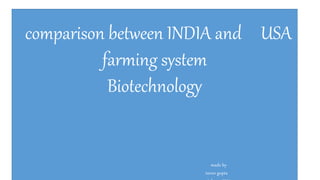
Agriculture farming system
- 1. comparison between INDIA and USA farming system Biotechnology made by tarun gupta
- 4. A farm in USA A farm in India 1. The size of the farm is large. 1. here the size of the land is comparatively small. 2. Owner's house is in the farm. 2. Owner lives in a main village and travels to the farm every day. 3. The farmer makes sure that soil and water resources meet the needs of the crop. 3. Due to inadequate supply of water and fertile soil, farmers have to purchase high yielding variety (HYV) seeds from market every year. 4. The farmer takes the help of technology and sends the soil samples to a soil testing lab to check whether the nutrients are sufficient or not. 4. The farmer in India takes advice from his friends and elders as well as government agricultural officers regarding farming. 5. The farmer uses tractors, seed drills, harvester and all kinds of modern agricultural machinery. 5. The farmer takes a tractor on rent, and many still rely on traditional bullocks for ploughing the land.
- 5. 6. The farmer owns a storage facility in the farm where he stores the crops before sending it to market. 6. He sells his crops in the mandi / market located in the nearby town. Since majority of the farmers do not have storage facilities and crops rot most of the time. 7. The farmer in USA works like a businessman. 7. Many farmers in India are peasants and get exploited by traders.
- 6. PROBLEMS IN INDIA AGRICULTURE •In India, the agriculture is not business, it is pride. It is hard to sell farm for a farmer. While in USA it is just instrument for income. •In India, people related with agriculture are the demand generating sector. What I want to say is that, if agriculture had bad year, it will affect the almost whole economy. •In India, there is pressure to feed 121 crore people. India has 1/3rd land as compared to USA. And 4 times population than USA. So, naturally, it will affect the policies of India. •Here, we have more illiteracy in villages. So, it is hard to spread information about government policies. If also govt. make efficient policies, they spend billions of rupees, but most farmers may be unknown about that policies. This fact also affect the modernization and use of technology in agriculture. • India suffers from black markets. Either selling final products in mandis or elsewhere, farmers generally get less price than MSP. (Because farmers don’t know about MSP. And also don’t know about their other rights.) Also, stock mafia affects the agriculture. And fertilizer’s are sold at more than MRP.
- 7. •Indian agriculture is mostly dependent on rain. Because of rising frequencies of El - Nino, agriculture have major step back. While USA is not dependent on rain. I mean they have better infrastructure in agriculture field. •As population is rising rapidly, per head availability of per hectare farm will be decreasing. And that directly affects the production and other things.
- 8. Difference in farming system • The biggest difference is in scale. The average US farm size is 178 ha while the average farm size in India is 1.06 ha (a decline from 2.63 in 1960–61). Less than 3% of the US population is involved in farming while 30 to 35% of the population is involved in farming in India. India crops rice and millet while corn and soybeans are the dominant US crops. • During the period from 1950 to 2000 farms in North America underwent a technological revolution with dramatic results. The average milk produced per cow went from 5,000 Lbs. to 18,000 Lbs. and the average yield of corn per acre went from 39 bushels to 153 bushels. Productivity in India from 1970 to 2000 rose in comparison 75%. • The average farmer in India receives only 15% of the price paid for his produce by the consumer. The average farmer in the US receives 70 to 75%.
- 10. Agriculture in India and USA 1. In INDIA, the total area under cultivation is 349 million acres and the 60–70% of the total population involved in AGRICULTURE and we are exporting agricultural products with market value of 46 Billion US$. 2. In USA, the total area under cultivation is about to 922 million acres and only 2% of the population is involved in Agriculture and they are exporting 175 Billion US$ value of Agricultural products. 3. In INDIA, our farms with small size up to 2 acres and with poor farm mechanization , But in USA, their farms are of size up to 400 acres with rich farm mechanization. 4. Our Indian products are with highly chemical content as we are using lots of chemicals to grow the plants and some countries prohibited our products. 5. Americans are using technology to grow the plants, and they have their own GPS, GIS and Remote sensing technologies and satellites for Agriculture and natural sources.
- 11. Head America India • Average Land holding- - Large Small • Means of farming Mechanised Mixed • Seed Quality - Very Good Moderate • Irrigation - Mostly Drip Mostly rain fed • Environment - Friendly to Agriculture Not so friendly to Agriculture • Warehouse facility for storage - Full Springly available • Transport Facility to Mandi's - Modern Traditional • Sale of agriculture product - Organised way Interference of political leaders • Price of product - Competitive Managed depending upon arrival agriculture product in mandi • Government Support - Nil - government schemes 1. Declaration of minimum support price 2. Subsidized electricity 3. No cost of water supplied for irrigation 4. Subsidized Fertilizer